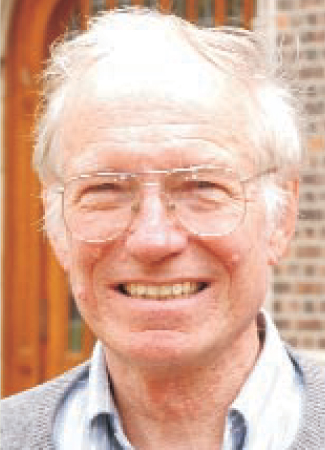President Presents National Medals of Science, Medals of Technology
DOI: 10.1063/1.1650074
Declaring that they “have given exceptional service in their fields, and bring great credit to themselves and credit to our country,” President Bush honored the laureates of the 2002 National Medal of Science and the 2002 National Medal of Technology at a White House ceremony this past November. The medals are the nation’s highest awards for scientific achievement and for technological innovation.
The National Medal of Science, which is administered by NSF, recognizes researchers who have made major contributions in science, engineering, or mathematics thoughout their careers. Including the winners for 2002, the National Medal of Science has gone to 409 individuals since it was first awarded in 1962. Of the eight recipients in 2002, six either are physicists or work in physics-related fields.
Leo Beranek received a medal for his “leadership, dedication, and contributions to the art and science of acoustics.” He was also cited for cofounding BBN Technologies in Cambridge, Massachusetts, “one of the world’s foremost acoustical research and consulting firms,” and for “sustained contributions to scientific societies and civic organizations.” Beranek, who retired in 1979 as director of BBN Technologies, is a consultant in acoustics.
John I. Brauman was cited for his “seminal contributions in chemistry, giving new insight into the properties of ions and the dynamics and mechanisms of reactions.” He was also acknowledged for his “landmark achievement in clarifying the key role of solvent in determining acid–base chemistry.” Brauman is the J. G. Jackson and C. J. Wood Professor of Chemistry at Stanford University.
Richard L. Garwin, Philip D. Reed Senior Fellow for Science and Technology at the Council on Foreign Relations in New York City, received a medal in recognition of his “research and discoveries in physics and related fields, and of his longstanding service to the nation by providing valuable scientific advice on important questions of national security over a half a century.” He is also a fellow emeritus at IBM Corp’s T. J. Watson Research Center in Yorktown Heights, New York.
James Glimm was cited for his “original approaches and creative contributions to an array of disciplines in mathematical analysis and mathematical physics, which are fundamental to the theory of operator algebras, shockwave theory, advanced quantum field theory, quantum statistical mechanics, applied mathematics, and scientific computation.” He is chair of the department of applied mathematics at SUNY Stony Brook and director of the Center of Data Intensive Computing at Brookhaven National Laboratory.
W. Jason Morgan was honored for his “development of the theories of plate tectonics and of deep mantle plumes, which revolutionized our understanding of the geological forces that control the Earth’s crust and deep interior and consequently influence the evolution of the Earth’s life and climate.” He is a professor of geophysics at Princeton University in Princeton, New Jersey.
NSF bestowed a medal on Edward Witten, Charles Simonyi Professor of Physics at the Institute for Advanced Study in Princeton, New Jersey. He was cited for his “leadership in a broad range of topics in mathematics and theoretical physics, including attempts to understand the fundamental forces of nature through string theory, and his inspired use of insights from physics to unify apparently disparate areas of mathematics.”
Technology Medal winners
President Bush bestowed the National Medal of Technology, which is administered by the US Department of Commerce, on three individuals, a team of three researchers, a team consisting of two individuals, and a company. Among the laureates are the following who are involved in physics-related work.
Calvin H. Carter Jr was recognized with a medal for his “exceptional contributions to the development of silicon carbide wafers, leading to new industries in wide bandgap semiconductors and enabling other new industries in efficient blue, green, and white light, full color displays, high-power solid-state microwave amplifiers, more efficient/compact power supplies, higher efficiency power distribution/transmission systems, and gem-stones.” Carter is one of the founders and currently the director of materials technology for Cree Inc in Durham, North Carolina.
Carver Mead received a medal for his “pioneering contributions to the microelectronics field that include spearheading the development of tools and techniques for modern integrated-circuit design, laying the foundation for fabless semiconductor companies, catalyzing the electronic-design automation field, training generations of engineers that have made the United States the world leader in microelectronics technology, and founding more than 20 companies.” He is the Gordon and Betty Moore Professor of Engineering and Applied Science Emeritus at Caltech.
A team medal went to M. George Craford, Russell D. Dupuis, and Nick Holonyak Jr for their “contributions to the development and commercialization of light-emitting diode (LED) technology, with applications to digital displays, consumer electronics, automotive lighting, traffic signals, and general illumination.” Craford is the chief technology officer of Lumileds Lighting in San Jose, California, and Dupuis is the Steve W. Chaddick Endowed Chair in Electro-Optics and a Georgia Research Alliance Eminent Scholar at the Georgia Institute of Technology. Both are former graduate students of Holonyak, who also received a National Medal of Science in 1990. Holonyak is a John Bardeen Chair Professor of Electrical and Computer Engineering and Physics at the University of Illinois at Urbana-Champaign.
DuPont in Wilmington, Delaware, won a company medal for its “policy and technology leadership in the phase out and replacement of chlorofluorocarbons in the environment during the past three decades.” The chair and CEO, Charles O. Holliday Jr, accepted the medal on behalf of the company.

Beranek


Brauman


Garwin


Glimm


Morgan
DENISE APPLEWHITE/PRINCETON U.


Witten
RANDALL HAGADORN


Carter
CREE INC


Mead


Craford
LUMILEDS LIGHTING


Dupuis
© 2003 GEORGIA TECH


Holonyak
BILL WIEGAND/UIUC

